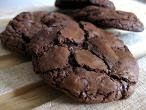I'd already made three breads by the time I got to this one and I was somewhat weary, so I tried out an overnight rise in the fridge. It worked really well and had the added advantage that the bread could come straight out of the oven for lunch. That’s got to be worth some daughter-not-in-law points, right? I’m so used to being careful with getting the water you add to the yeast warm enough to activate it that it didn’t seem right that rising could happen at such a low temperature, but I suppose it’s because the yeast has already been activated before it goes in the fridge. Anyway, it worked a treat, and I just let it sit on the counter for a while to return to room temperature the next day before shaping and baking it.
350g strong white flour
150g plain flour, preferably Italian 00
7g/1 sachet instant yeast or 15g fresh
2 tsp salt
300-400 ml warm water
3 tbsp olive oil
handful of sage leaves
Red onion, chopped into thin slivers
Combine the flours, yeast and salt in a bowl. Pour 300ml of the warm water into a measuring jug and stir in the 2 tbsp olive oil. Pour the liquid over the dry ingredients and mix to form a soft but firm dough, adding more water as necessary.
Now start kneading until smooth, supple and 'full of elastic life'. Form into a ball and place in an oiled bowl. Cover with oiled clingfilm and leave to rise for an hour or so until doubled in size - or overnight in the fridge.
If you've let it rise in the fridge, take it out and let it come back to room temperature before shaping. Now sit it in a roasting tin and press to fit, letting it rest for a few minutes if it looks as if it's never going to stretch to all four corners (it will). Cover the dough with a tea towel and preheat the oven to 220C/Gas 7. After 30 mins or so, the dough should be puffy and ready to be topped.
Poke your fingers all over the dough to dimple it and scatter torn sage leaves and onion over the top. Bake ten minutes, then reduce the heat to 190C/Gas 5 and cook for a further 15-25 mins until it's golden brown. Remove from the tin and cut into big slices
Other topping ideas: other fresh herbs, garlic (roasted and smushed, if you like), or mashed up gorgonzola and pine nuts, as Nigella suggests.





3 comments:
looks delicious - I like the idea of leaving the dough in the fridge overnight - haven't done this before as, like you, I think I have trouble believing it will work - and can you clarify what 00 flour is - does this mean quite a light cake or all-purpose flour?
Hi Johanna! It seems weird doesn't it, but it really does work!
00 flour is the sort you use to make pasta, and Nigella quite often uses it in pastry as well. Apparently it's made from coarsely ground durum wheat, and holds it shape well. According to a website I just found in Italy pasta flour is commonly known as semolina, but we do get that here too, so I'm not absolutely certain if it's the same thing. Not sure if that helped at all!
Oh, Lovely Focaccia! As you may have noticed bread is one of my very favorite foods to eat :) Love the addition of the fresh herbs in both loaves, they not only add to the flavor but make the focaccia look extremely appealing!
I'm certain you scored some points with the Scientists parents with the lovely lunch you prepared. How nice to have the chance to show of your cooking and baking skills.
Post a Comment